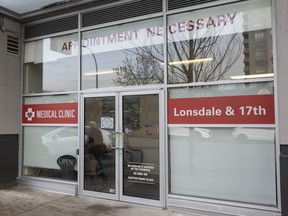Shortage of doctors and incentives to work in family practice has cut walk-in clinics by a third to a half in B.C.

The NDP’s efforts to improve health care through a new payment model for family physicians and the establishment of urgent and primary care centres has had the unintended consequence of cutting the ranks of walk-in clinics across the province.
According to the medical mapping service MediMap, the number of walk-in clinics across B.C. has dropped between 30 to 50 per cent in recent years as clinics move to an appointment-only model or close their doors.
This has led some doctors to warn that there are fewer and fewer options for immediate care in the province as urgent-care-clinic appointments remain hard to book in certain communities and emergency room waiting times continue to skyrocket.
Rita McCracken, a family physician and UBC assistant professor in the family practice department, said part of the problem is the new payment model introduced by then-health minister Adrian Dix in 2023 that aims to retain family physicians through better compensation. The model encourages doctors to work in family practice instead of putting in hours at a walk-in clinic, she said.
She likened health care to the education system and wants the province to increase the capacity of primary care, arguing that neither walk-in clinics nor urgent and primary care centres are an ideal model.
“If we want people to have better access to primary care when they need it, we need to have clinics that have the capacity to be able to provide care to the people that live close by, just like we do for elementary schools,” McCracken said.
“I’m not saying that there aren’t many, many problems with education right now, but if we just kind of take a look at that model of access to public education, we’ve completely thrown that out the window when it comes to primary care.”
She said there needs to be a wholesale rethinking of how primary care is provided to people without a family doctor and that interested parties such as municipalities and community groups need to come together to figure out a solution.
Some physicians say they have seen first-hand the effects of the decline of walk-in clinics.
Kevin Mcleod, a North Vancouver-based internal medicine specialist, says people now come to see him for basic ailments, such as a bladder infection, that would be better dealt with by a general physician.
“They don’t need to see me as a specialist, but they have nowhere else to go.”
Mcleod said a walk-in clinic across the street from his office has papered over a sign saying “no appointment necessary,” indicating it has moved to an appointment-only model.
The company that owns the clinic, Well Health Technologies Corp., did not respond to a request for comment, but a representative of the North Vancouver clinic said it does still accept non-registered patients, those patients now need to make an appointment.
“I know the government gives their statistics that thousands of people are getting attached to a family doctor, but there’s still 800,000 people who aren’t and where do they go?” asked McLeod. “A lot of people don’t realize (that) if your family doctor retires or deactivates their college number, any outstanding refills or renewals of medications that you might have at your pharmacy are all automatically cancelled.”
Josie Osborne, B.C.’s new health minister, told Postmedia she is aware of the challenges in getting primary care.
Osborne says the main challenge is the shortage of health-care professionals in B.C. and believes the province’s efforts to recruit more physicians, nurse practitioners and other health workers fields will help.
As for treading the line between encouraging doctors to go into family practice and working at a walk-in clinic, the minister said it will be a matter of working with family doctors and health-care professionals in each community.
“The nature of the way primary care is being delivered is changing, and we’re seeing that in what physicians want, in terms of their work life, their work style, but also in needing to stand up clinics that work for communities and being able to tailor them well for what a community’s needs are,” said Osborne.
MediMap CEO Thomas Jankowski said solutions are needed in short order as the closures of clinics has made waiting times at remaining walk-in clinics rise by 60 per cent. Meanwhile, emergency room waiting times continue to worsen as more people lose access to other options for primary care.
According to the provincial government’s website, all or most of the walk-in clinics in communities like Victoria, Surrey, Langley and Maple Ridge are by appointment only. Nanaimo only has one walk-in clinic.
“Wait times at ERs are getting horrific right now, and this might be actually the first year that we’ll talk about ER waiting times more openly as we’re starting to monitor those across the country as well. We’re seeing now the first year in which it’s quite regular to see entire ERs close because of staffing issues because of doctor burnout,” said Jankowski.
“I just feel that health care is very much in a free fall right now, and we’re not really thinking of systemic solutions in a way that truly address this, as opposed to moving the puck from one place to another, which isn’t working.”